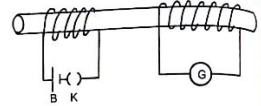Take a soft iron bar. With the help of insulated copper wire make two separate coils as shown in fig. To one coil connect a battery with a key. To another coil connect a galvanometer. Press the key. Do you observe deflection in the galvanometer? What happen when the key is opened?
 Solution in Punjabi
Solution in Punjabi
Step by step video & image solution for Take a soft iron bar. With the help of insulated copper wire make two separate coils as shown in fig. To one coil connect a battery with a key. To another coil connect a galvanometer. Press the key. Do you observe deflection in the galvanometer? What happen when the key is opened? by Physics experts to help you in doubts & scoring excellent marks in Class 10 exams.
Updated on:21/07/2023Topper's Solved these Questions
- MAGNETIC EFFECTS OF ELECTRIC CURRENTBOOK - MODERN PUBLICATIONCHAPTER - MAGNETIC EFFECTS OF ELECTRIC CURRENTEXERCISE - EXERCISE
265 Videos
- ELECTRICITYBOOK - MODERN PUBLICATIONCHAPTER - ELECTRICITYEXERCISE - EXERCISE
303 Videos
- REFLECTION AND REFRACTIONBOOK - MODERN PUBLICATIONCHAPTER - REFLECTION AND REFRACTIONEXERCISE - EXAMPLE
138 Videos
Similar Questions
Write the S.I. unit of magnetic field →B.
View SolutionDefine electric current and give its unit
View SolutionA concave mirror of focal length 20 cm forms a real image at a distance of 40 cm. find the position of the object.
View SolutionA coil of insulated copper wire is connected to a Galvanometer. What happens, if a bar magnet is…………. pushed into the coil?
View SolutionA coil of insulated copper wire is connected to a Galvanometer.
What happens, if a bar magnet is………….
withdrawn from inside the coil?
View SolutionA coil of insulated copper wire is connected to a Galvanometer. What happens, if a bar magnet is…………. held stationary inside the coil?
View SolutionTwo coils C_1 and C_2 are kept coaxially as shown the coil C_1 is connected to a battery and the coil C_2 is connected to a galvanometer. The deflection in galvanometer can be increased by
View SolutionWhat is electromagnetic induction ? A coil of insulated copper wire is connected to a galvanometer. What will happen in the galvanometer if a strong bar magnet is . .. (1) pushed into the coil ? (2) withdrawn from inside the coil ? (3) held stationary inside the coil ?
View SolutionA coil of insulated copper wire is connected to a galvanometer, what will happen if a bar magnet is pushed into the coil
View SolutionA coil of insulated copper wire is connected to a galvanometer, what will happen if a bar magnet is Withdrawn from inside the coil.
View SolutionA coil of insulated copper wire is connected to a galvanometer what will happen if a bar magnet is held stationary in the coil?
View SolutionIn the arrangement shown in figure,there are two coils wound on a non-conducting cylinderical rod.Initially the key is not inserted.Then the key in inserted and later removes.Then, A. The galvanometer will not deflect B. The galvanometer will deflect in one direction when the key is inserted and in the opposite direction when the keys removed C. The galvanometer will deflect in one direction when the key is inserted and remain still when the key is removed . D. The galvanometer will deflect in one direction when the key is inserted and in the same direction when the key is removed .
View Solutionकोई विद्युत्रोधी ताँबे के तार की कुण्डली को किसी धारामापी से जोड़िए। क्या होगा यदि दण्ड चुम्बक को
कुण्डली में धकेला जाए।
View Solutionकोई विद्युत्रोधी ताँबे के तार की कुण्डली को किसी धारामापी से जोड़िए। क्या होगा यदि दण्ड चुम्बक को
कुण्डली के भीतर स्थिर रखा जाए।
View Solutionकोई विद्युत्रोधी ताँबे के तार की कुण्डली को किसी धारामापी से जोड़िए। क्या होगा यदि दण्ड चुम्बक को
कुण्डली के भीतर से बाहर खींचा जाए।
View SolutionAnswer the following questions : Take two coils of about 50 turns. Insert them over a nonconducting cylindrical roll as shown in fig. A thick paper roll can be used . Connect coil 1 to a battery with a plug key k. Connect coil 2 to a galvanometer G. plug the key and observe the deflection in the galvanometer. Unplug the key and again observe the deflection. Note ( your observations. What conclusions do you draw from these observations?
View Solution
